Nowadays, the generations who have blithely soiled the planet with outrageous liberalism, preaching the virtuous mechanics of the “invisible hand”, are asking the new generations to stop consuming, eating and breathing in order to avoid nothing less than the end of the world.
Admittedly, there is nothing new about fixing the mistakes of previous generations: the Germans – but not only them – have just spent 7 decades apologizing for the hysterical delusions of generations born late nineteenth / early twentieth centuries.
Moreover, those who have to induce change, need to hold all the cards for that matter.
Unfortunately the environmental agenda has become a huge communication operation in which all kind of interests have become entangled, starting with countless economic ones – often far from any real ecological concerns – manipulating the good ol’ human emotions – fear of death, fear of change. It is quite difficult to see clearly in this claptrap producing more and more incoherence every day and multiplying the contradictory and / or thwarted injunctions: “consume (the economy must move on) without actually consuming (the planet must remain clean)”; “buy electric cars… oh no, finally it’s better to stop buying”; “sort your trash … even if, ultimately, it goes to Asia where it is thrown into the sea”; “we need reprocessing plants… but not in my backyard”… The panic that creeps onto humanity (due to titanic issues that only the greatest disorder seems to oppose) is not really auspicious. Soon, time to calm down.
The environmental challenges are real … as real as they were in the Middle Ages with the rise of cities and human encroachments. Certainly, awareness must be raised. But Armageddonist communication operations filled with ready-made injunctions will eventually weary a human society rendered powerless by the scale of the task and the strategic inconsistency.
It is time to move to a scientific approach in line with educational actions questioning the evidences in order to rationalize the situation and the stakes of the ecological crisis, but also to create the conditions for an enlightened collective involvement of citizens in the implementation of long term solutions…
The following article, written by Christel Hahn, is an example of the kind of salutary questioning that the environmental issue needs to undergo so that the new generations can properly implement programs for cleaning the planet, that are also respectfull to man, a task, that will occupy many of them up to 2040.
Fridays for Future
The young people, especially in Germany, stand up and say: “Stop! We want our future, we want to live”. The political leadership goes on as if nothing happened and the young people vote Green[1]. The political leadership is paralysed. Rezo’s video is to blame. The climate cabinet meets and discusses, the Minister of Economy needs more clarification, the Minister of Environment puts some pressure and Greenpeace is at the door. The SPD tears itself apart. The CDU is debating. The young people say “you are no longer our parties, it is the Greens now, they are cool and let the members decide”[2].
What is the reaction of the political leadership?
The political world has a unilateral relationship with its citizens. On the one hand, it has its own aims, agendas and strategies. On the other hand, it needs the citizens (as taxpayers, voters, consumers, employees…) to implement those aims.
In a democratic system, the political world is supposed to explain to the citizens what is happening or, better, it could ask them what they want. In reality, it prefers another path: to create a narrative, a story, which will help mobilising people. In our Internet world, it’s called a meme, and today’s meme is climate[3].
One of the first to do this and probably the inventor of the meme was the British chemist and Prime Minister of the 1980s, Margaret Thatcher. Mrs Thatcher wanted to end her country’s dependence on the miners’ unions (and therefore on coal) . Her mandate was marked, on the one hand, by the one-year miners’ strike of 1984/85 and, on the other hand, by the creation of the Intergovernmental Panel on Climate Change (IPCC). With the help of the climate meme she defeated the strikers, broke the union power and closed the coal mines[4].
In the United States it is expressed by Alexandria Ocasio-Cortez, currently one of the most representative politicians of the younger generation, a member of Congress and opponent of climate-denier[5] Donald Trump.
In a tweet of May 12[6] she notes that it takes the “social intelligence of a sea sponge” to take the statement that “the world will end in 12 years” literally… And she clarifies: “Climate change is here + we’ve got a deadline: 12 years left to cut emissions in half. A #GreenNewDeal is our plan for a world and a future worth fighting for”[7]. So we have here a real agenda to change the world (and the future).
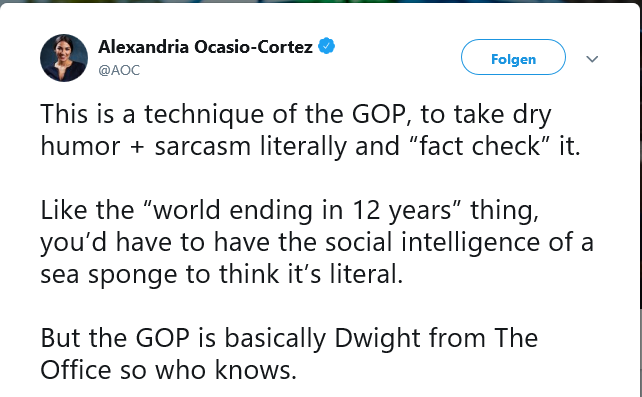
Behind the climate meme lies a huge coordinated public relations effort. The Guardian, one of the opinion-making journals in Europe, has recently adapted its terminology policy. As part of the update of its style guide, it wrote: „Instead of ‘climate change’ the preferred terms are ‘climate emergency, crisis or breakdown’ and ‘global heating’ is favoured over ‘global warming’, although the original terms are not banned“[8].
Carbon dioxide – a measure for pollution
Not only has a meme been launched, but with carbon dioxide also a kind of measure (or currency) for pollution. For centuries, industrial and individual activity has mainly relied on energy released by the combustion (oxidation) of carbon from wood / coal / oil / gas to carbon dioxide. Carbon dioxide is thus a measure for this kind of polluting activities and the trade in pollution rights also makes it a kind of currency[9]. Carbon dioxide emissions (or more simply carbon emissions) are therefore generally used as a measure of harmful human activity or the degree of climate damage. Expressions like carbon footprint are now part of standard vocabulary[10].
All this is perfectly illustrated by the following graph: carbon emissions indicate that the population and industrial activity are stable or declining in the West, while they are rising in the rest of the world.
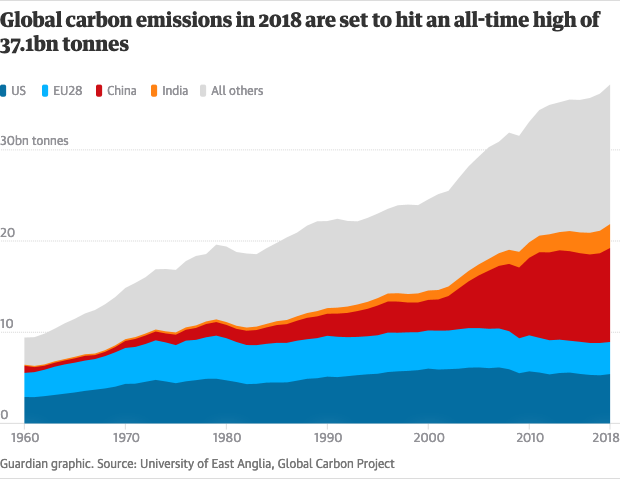
Figure 1 – Evolution of global carbon emissions according to the world region. Source: University of East Anglia, Global Carbon Project
A fast changing world
The political world is not necessarily forward looking, but acts driven by polls and and the date of the next elections. However it is surrounded by foundations, think-tanks, international organisations and these are carrying out medium or long term analyses. These analysts are obviously aware that we are facing huge changes and adjustments at the beginning of this millennium. Driving factors are, to name only the most obvious: an ever growing world population, even though the increase has already slowed down, an overall growth of prosperity, a period of peace of nearly 75 years since the last world war, the global spread of capitalism, the emergence of a large number of new players (yesterday, third world countries; now, emerging countries or new powers in their own right as they are…).
To understand what the meme climate stands for, the easiest and most pragmatic answer (Ockham’s Razor[11]) is; that it allows the needed adjustments to cope with these changes, framing current policies and making people adhere to these policies, regardless of short-term election dates. Beyond the climate issue, it is about preserving the viability of a 10 billion inhabitant planet and for this a new balance between world regions.
The austerity paradigm
As we are atavistically programmed for austerity rather than for abundance, the programme to overcome this global crisis is, in fact, a matter of restriction, self-incrimination and guilt: we, as human beings, are shedding too much CO2 in the world, and the planet will die of heat if we do not all limit ourselves massively. More than that: the white man with his huge CO2 emitting car is responsible for the coming death of the inhabitants of poor countries, who can not escape the sea level increase…
The Paris climate summit marked an important step in the implementation of this programme, with the adoption not only of ambitious climate targets (for industrialised countries), but also of the Green Climate Funds. The financial fund established in the Incheon Free Economic Zone in South Korea is receiving the huge sums[12] promised under the Paris Agreement and is investing them for projects in “poor” countries: “The Green Climate Fund (GCF) is a new global fund created to support the efforts of developing countries to respond to the challenge of climate change. GCF helps developing countries limit or reduce their greenhouse gas (GHG) emissions and adapt to climate change. It seeks to promote a paradigm shift to low-emission and climate-resilient development, taking into account the needs of nations that are particularly vulnerable to climate change impacts”[13].
If poor countries develop in the same way as rich countries, there is a risk of collapse. This is why the money of the latter is invested in the first to help them limit themselves to a moderate share of the cake.
Regarding a control of the financial flows, the GCF website briefly states that “the GCF reports to the United Nations”.
… vs the prosperity paradigm
This austerity program seemed to work well until Donald Trump got elected with his counter-program, Make America Great Again! (MAGA), opposing a prosperity program to an ambient austerity program, starting from completely different principles: the problems can be solved by the liberation of our potential, the wealth is not a flaw and can be used productively, each challenge generating actually solutions[14]. So a NO to the reduction of human activities and YES to modernisation via investments.
The basis of Trump’s populist agenda is aimed at giving the “deplorables” [15] good jobs by repatriating industrial jobs to the US, raising wages and cutting taxes, in order to unleash the potential of a country of 327 million inhabitants.
Regarding the climate, the Paris Agreement was denounced (and, along with it, the contributions to the South Korean fund, which even Obama had never dared to get approved by Congress).
This approach is gaining importance through the rise of similar populist agendas in Europe and around the world. The conditions for a debate are therefore posed on the basis of contradictory positions, forcing citizens to become smart to assess the situation and find the solutions themselves.
The ‘climate kids’
The rising generation, especially the German one, has internalised the climate meme. Today’s 18-year-olds have grown up not only in a reunified Germany, Europe, the Euro, Internet but also in the climate meme. But they are taking the end of the world in 12 years seriously and have decided not to put up with it, demanding concrete action from politicians to stop global warming. Most of them voted Green in the European elections. They also take to the streets every Friday[16] and largely contribute to the upheaval of Germany’s political landscape: the Greens overtake the CDU in the polls; the SPD continues to collapse and drifts to the green left. Since it has become clear since the last Bundestag elections that the ruling parties are no longer able to win a majority, that is able to form a working government, a black-green coalition – or even a green-black coalition already tested in the industrial heartland of Baden-Württemberg – is announcing itself currently to implement the necessary adjustments fast.
With its likely arrival in power in Germany, the climate movement is today at a crossroads: perpetuation of the abundance mantra, development of potential, investment in innovative technological solutions,… or invention of non-growth, de-consumption, tax-penalties models…[17]
In France, the second scenario led to an uprising of the Yellow Vests. In Germany, dominated by the theme of guilt[18], there is a strong tendency towards state regulation, more or less official increases in taxes and levies, tightening of belt by a few extra notches and so on, but there are also strong trends of developing the best of both worlds.
An example of this third path is the German Environmental Management System, EMAS, which has been adopted by the EU, namely a circular system based on continuous improvement of participating companies and organisations. Even though it involves a certain bureaucracy and relies on a legal and regulatory framework, it is above all a system focusing on the specific situation of the participating company, improves it continuously and help employees play an active role[19].
Even if the austerity paradigm relies on solid structures and sophisticated public relations, there is indeed much potential for the new youth movement not to get stuck in it. Having grown up in wealth, networked in a very complex world, the younger generation has all it takes to break out of the austerity paradigm imposed by the baby boomers, distinguishing between real wealth and superfluous wealth to invent a positive prosperity paradigm.
On this specific path, there are both opportunities and obstacles: digitisation / virtualisation with its very last form: artificial intelligence. This is one of the causes of the great world crisis: without it, neither ideas, nor people or goods could cross the planet with such intensity. But it is also a fundamental prerequisite for finding solutions to the numerous problems of our planet[20].
In a way, the carbon dioxide discussed above is also a virtualisation of the environmental problem (and that’s why the meme works so well): now we have one single quantity whose combat, avoidance, taxation, … will save the world. Similarly, the global transition to electricity is a virtualisation of energy supply. Or finance a virtualisation of the economy…
But the emergence of these virtualised representations also entails the risk of losing contact with reality. Indeed, mobile phones and computers are also real objects that consume energy[21], can turn into addictive devices and have not only non-thermal but also thermal effects[22].
Fortunately, the new generation seems to be aware of the situation and that of the environment. Recently, the problem of species extinction has arisen (if the insects die, we can not do well either) and the Bavarian citizen save-the-bees petition[23] has just become a European citizens’ initiative.[24]
Questioning the possible link between carbon and pollution
Greta Thunberg’s mother wrote in her recently published book: “Greta is one of the few people who can see our carbon dioxides with the bare eye. She sees the greenhouse gases streaming out of our chimneys, rising into the sky with the wind and turning the atmosphere into a gigantic invisible garbage dump. She is the child, we are the emperor. And we are all naked”[25].
This is an example of one of the biggest misunderstandings about carbon dioxide. While humanity and all other forms of life suffer from the fact that they are increasingly exposed to substances to which they are not genetically adapted, carbon and its cycles are one of the basic building blocks of life (see the chemistry and biology classes). Carbon is an essential structural element of any form of life and carbon dioxide is one of the stages of the carbon cycle released not only by combustion-based industrial processes, but everywhere and permanently by the metabolism of all forms of life, especially all animal species[26]. In the air, it is an invisible gas (0.04%), as such, it is not toxic (although it can cause death if it expels oxygen from the air).
Despite Greta’s clairvoyance, what can be seen in the pictures of the smoking chimneys is not carbon dioxide, but water vapour on one side (that’s why the cooling towers of nuclear power plants produce these same images) and the dirt on the other side, that is to say, tiny polluting particles. The dirtiest process is coal burning, which releases the highly toxic coal fly ash. In the West, this dirt is retained by filters, but not at all, or almost not in the old Indian and Chinese coal plants. It is hardly surprising that China and India rely so much on electro mobility: in their highly polluted megacities, the health and life expectancy of their inhabitants are extremely threatened by what we identify as smog. And these dirt particles, found even in the Himalayas, contribute to global warming.
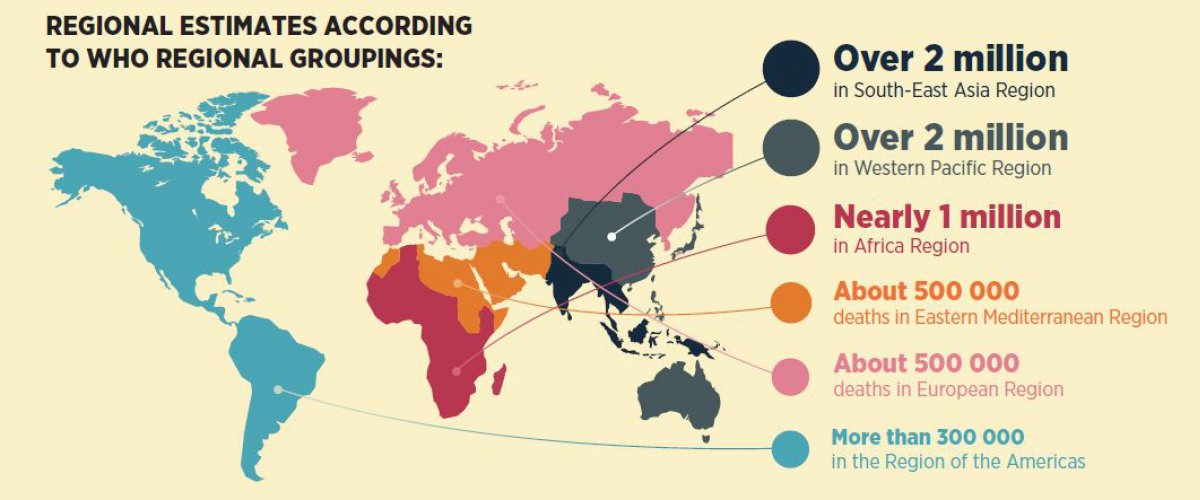
Figure 2 – Annual deaths due to air pollution. Source: Climate & Clean Air Coalition
The limits of the climate meme
The climate meme has had its usefulness in initiating the necessary transformations. But the moment seems ripe now to replace it with a mor inclusive life affirmative humanism meme. Only by placing creation, life, man, consciousness … at the centre of things, there will be a real modernisation and we will take the step further, towards a future worth living.
Here are three concrete examples of the limits of the climate meme:
- Climate is a symptom not a cause. In recent years, extensive damage has been caused in Germany by floods due to extreme weather events[27]. There have been serious experts, who explain that this was not the consequence of abstract global warming, but of agriculture and land use that has led to extreme humus degradation. Humus. Soils poor in humus are much less able to store moisture than soils rich in humus, but they also have a decisive influence on the atmospheric water vapour cycle. There is a general consensus that water vapour plays a major role in the greenhouse effect, some even say that it plays a more important role than carbon dioxide. Humus means living soil, it is not only an essential condition for a healthy climate, but also for a healthy and invigorating diet and its salvation requires concrete measures, namely the conversion of agriculture to modern biological methods[28].
- Evidences must be questioned. It is well known that the accelerated transition to electromobility makes traffic quieter and less polluting, but poses other environmental problems. According to the ancient slogan of the antinuclear movement (“In our place electricity comes directly from the socket”), the cleanliness of the electrical energy depends on that of its production[29]. Moreover, there are environmental problems caused by batteries (for example, lithium mining). It is also known that the diesel scandal (this is actually about particle pollution) was ultimately caused by the imperative of saving carbon dioxide. In the transportation sector, which makes our cities uninhabitable, cuts through our landscapes and is still based on 19th century technologies there is an urgent need for a complete modernisation taking into account a wide range of requirements (urban, rural, supply chains, etc.).
- A leap into modernity is needed. Our growing energy needs[30] are mainly met by the chemical process of combustion. The availability of fuels makes states interdependent and has triggered many conflicts since old times. The climate meme wants to ban the combustion (that is to say the release of carbon dioxide) [31]. What is the alternative? After the nuclear bomb of the Second World War, it seemed logical to use this huge release of energy in a peaceful way, but the current nuclear reactors are not very modern[32]. The sun energy is being captured, but using very traditional means. Hydroelectric power is one of the oldest methods of energy production. And best of all, we now get energy from cultivated plants, the famous energy plants. The climate meme has not yet succeeded in generating a modernisation breakthrough, but there are promising approaches urgently needed: hydrogen, methanisation of waste, fuel batteries, 4th generation nuclear reactors, nuclear fusion, new nuclear processes (such as LENR – low energy nuclear reactions), free energy…[33]
Updating scientific research
Science is one of the most important creations of human beings, one of the most essential manifestations of humanism and a prerequisite for the creation of wealth and abundance. But what about scientific research?
The work of the Intergovernmental Panel on Climate Change (IPCC), since the days of M. Thatcher, is one of the most important drivers of global change. Yet it is not a scientific institution, but a political one, in this case a sub-organisation of the United Nations.
Most of climate research is applied research and may be more in the field of sociology or prospective than in natural sciences. As the title of the Potsdam Institute shows, it is about evaluation of climate impact. The method is modelling and the results vary from moderate to alarmist. But the output data are only as good as the algorithms and input data. As with Google, the algorithms are rather opaque and the quality of the input data has been subject of lively debates on many occasions. The data situation on sea-level rise provides a good illustration of this[34]. And there are nuanced counter positions, especially from the civil society[35].
Not so much in the public focus are the physical fundamentals. This is not surprising, since atmospheric physics is a highly complex topic and is difficult to access for physically educated laymen or scientists from other disciplines. One of the basic questions that this atmospheric physics can answer is how strong the absorption effect of long-wave radiation by carbon dioxide is. There is also applied physics, which can, for example, answer the question of whether the rise in carbon dioxide in the atmosphere causes the warming or whether it causes the rise in carbon dioxide (e.g. through outgassing from the oceans).
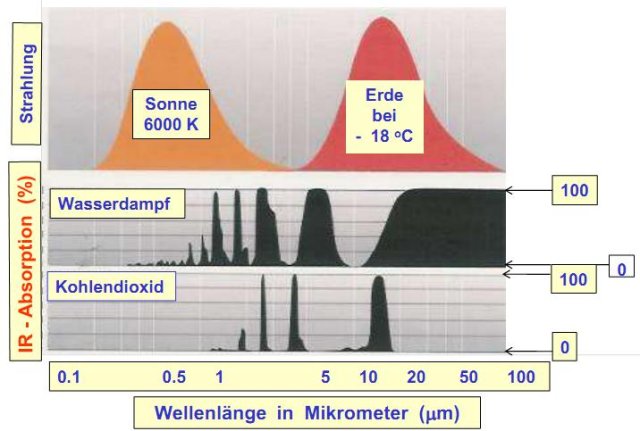
Figure 3 – Absorption spectrum of carbon dioxide and water vapour. Source: Chemieonline.de
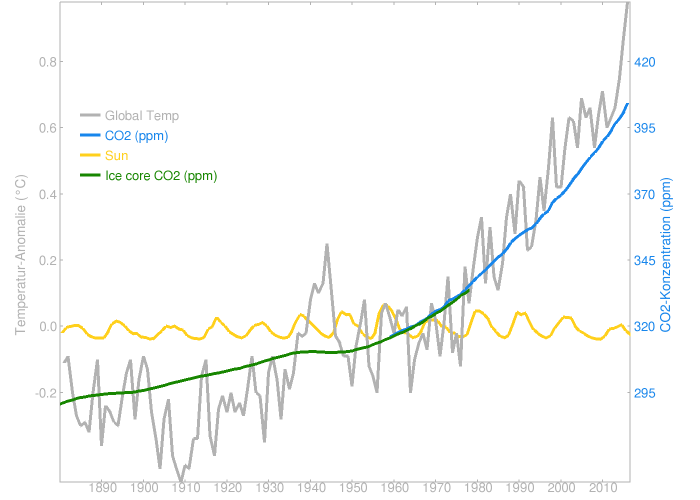
Figure 4 – Temperature and increase of carbon dioxide. Source: scilogs.spektrum.
Answering these two questions, raised here as an example, is of great importance for many major future decisions (concerning the considerable investment in carbon dioxide storage, for instance). There are certainly controversial views to both of these issues. Yet only the experts have the skills for qualified debates. In the public sphere, the fronts are as stubborn as during the Copernican revolution of the image we had of the Earth.
One of the most urgent tasks is to adapt scientific research to the 21st century and its challenges. But how to get there when research is funded by politics, the careers of scientists depend on their publications, there is still a lack of permeability between disciplines, and the work of individual researchers is increasingly specialised? And how to make these works of scientific rationalisation of the environmental situation and proposals for solutions accessible to the general public?
These are two major issues to start a successful ecological transition[36].
Gerald Pollack‘s Institute for Venture Science (IVS) states: „Major breakthroughs come around far too infrequently. It’s been over half a century since DNA was discovered and a century since the discovery of sub-atomic particles. IVS is a “black swan” incubator for open discovery of paradigm changing insights. By managing modest investments in open exploration of ideas that possibly have enormous ramifications for humanity, IVS increases the likelihood of major breakthroughs. These breakthroughs can build entirely new industries and transform existing ones; they can lead to medical and technological breakthroughs; and they can help humankind with the challenge of managing the environment“.[37]
Science with conscience … This kind of discourse is likely to make us pass from the ecolo-millenarianism era to that of healing the environment, an exciting project for young people instead of the weight of the original sin of withering, a genesis instead of the currently proposed apocalypse.
This paper is also available in German from Christel Hahn’s blog
Christel Hahn, Physicist, Software developer, Translator and Shop assistant.
Notes:
[2] The first of the new parties. Born out of the radical ecologist movement and the new left of the 1970s, its image, dominated until recently by baby-boomers like Trettin, Künast, Kuhn, Bütikofer and Roth, has radically changed (now rejuvenated and renewed).
[3] Source: t-online, 17/06/2019
[4] After being in office, she showed a U-turn in her opinion. Source: The Ecologist, 17.10.2018
[5] How to deny the climate? … In fact the term climate-denier is commonly used.
[6] Source: Twitter, 12/5/2019
[7] Source: Twitter, 17/4/2019
[8] Source: The Guardian, 17/5/2019
[10] However, there are processes which fall completely outside this pattern, for example nuclear energy, which is thus described as clean and is experiencing a boom.
[12] Source: World Resources Institute
[13] Source: Green Climate Fund
[14] „And just as with so many other problems humanity has faced, environmental problems should be solvable given the right technology and spreading prosperity“. Source: CAPX, 13/06/2019
[15] The rustbelt workers’ votes, whose jobs were delocalised to Mexico, China, had a final impact on the 2016 election. See also Thomas Wictor on Quodverum, 14/3/2019
[16] Created by Greta Thunberg. Source: Fridays for Future
[17] The Klima-Kids criticised by a techno-blogger. Source: Hitzestau, 05/02/2019
[18] See for example: Verein Kriegsenkel e.V.
[19] Sources: Europäische Kommission, EMAS
[20] See for example: LEAP, 14/08/2018
[22] Source: 5gspaceappeal
[23] Source: The Guardian, 19/02/2019
[24] Source: SofiaGlobe, 15/05/2019
[26] If one takes the demand to stop all carbon emissions literally, then one would have to ban exhalation. This widespread ignorance of the nature of carbon and carbon dioxide alone speaks a lot about the fundamental hostility to life inherent in the austerity paradigm.
[27] Here the most prominent German-speaking weather forecaster, Jörg Kachelmann, about this year’s weather. Source : t-online, 07/06/2019
[28] For example, with the Terra Preta technology humus is built up by activated bio-charcoal (carbon storage!). See for eg. Arbeitsgemeinschaft bäuerliche Landwirtschaft
[29] However, electricity generation in China will continue to be based on coal-fired plants for the foreseeable future, and in France electricity comes from largely obsolete nuclear power plants.
[30] Source: Agentur für erneuerbare Energien
[31] It cannot be excluded that the demand decline in fuels and heating oil has led the oil industry to increase the output of plastics, the use of plastics having increased rapidly in recent years.
[32] Based on the vapour machine principle. Source: Greenpeace
[33] End of studies thesis of a 17-year-old Austrian: Nevertheless, I think it would be useful to invest in free energy, because we would have the opportunity to protect our environment and help more poor countries without having to give up our high living standard. Source: OEVR.
[34] Since the earth is not a rigid bathtub, there is both an influx of water into the oceans as well as uplift/lowering of land mass. . Sources: NoTricksZone, 13/02/2019; Newstarget, 18/02/2019; NoTricksZone, 04/12/2017; Springer, 6/11/2017; Correktiv, 03/06/2019
[35] For eg. Patrick Moore (the sensitive ecologist) pleads for the humans at the centre of attention. Source: Ideacity, 2015
[36] As early as 2001, Jacques de Gerlache in Belgium answered these two questions by creating the site GreenFactsInitiative to make known all scientific information on the environment.
[37] Source: Institute for Venture Science


 LEAP2040 Toutes les informations et archives Europe2040
LEAP2040 Toutes les informations et archives Europe2040



